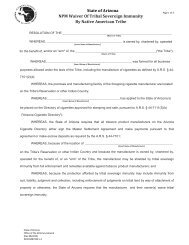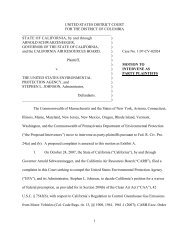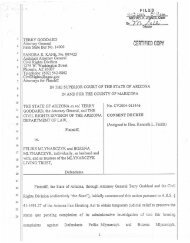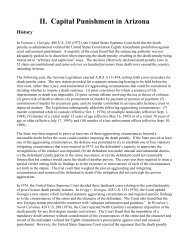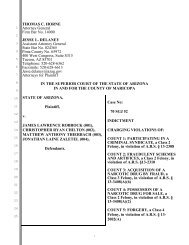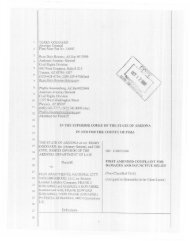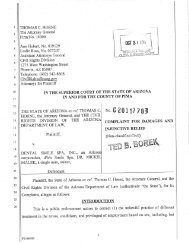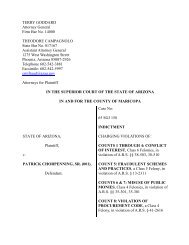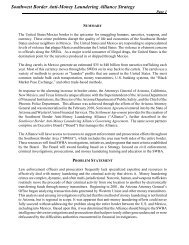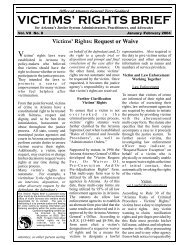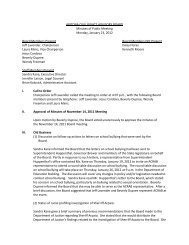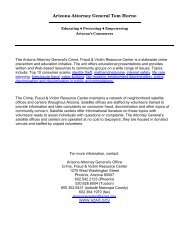2010 Arizona Youth Survey - Arizona Attorney General
2010 Arizona Youth Survey - Arizona Attorney General
2010 Arizona Youth Survey - Arizona Attorney General
You also want an ePaper? Increase the reach of your titles
YUMPU automatically turns print PDFs into web optimized ePapers that Google loves.
The Risk and Protective Factor Model of Prevention<br />
Prevention is a science. The Risk and Protective<br />
Factor Model of Prevention is a proven way of<br />
reducing substance abuse and its related consequences.<br />
This model is based on the simple premise that to<br />
prevent a problem from happening, we need to<br />
identify the factors that increase the risk of that<br />
problem developing and then find ways to reduce<br />
the risks. Just as medical researchers have found risk<br />
factors for heart disease such as diets high in fat,<br />
lack of exercise, and smoking, a team of researchers<br />
at the University of Washington have defined a set<br />
of risk factors for youth problem behaviors.<br />
Risk factors are characteristics of school,<br />
community and family environments, and of<br />
students and their peer groups known to predict<br />
increased likelihood of drug use, delinquency, school<br />
dropout, and violent behaviors among youth. For<br />
example, children who live in communities with<br />
physical deterioration and high rates of adult crime<br />
are more likely to become involved in delinquency<br />
and drug use than children who live in organized<br />
neighborhoods.<br />
The chart below shows the links between the 19 risk<br />
factors and five problem behaviors. The check marks<br />
indicate where at least two well designed, published<br />
research studies have shown a link between the risk<br />
factor and the problem behavior.<br />
Protective factors exert a positive influence and<br />
buffer against the negative influence of risk, thus<br />
reducing the likelihood that adolescents will engage in<br />
problem behaviors. Protective factors identified<br />
through research include strong bonding to family,<br />
school, community and peers, and healthy beliefs and<br />
clear standards for behavior.<br />
Research on risk and protective factors has important<br />
implications for children’s academic success, positive<br />
youth development, and prevention of health and<br />
behavior problems. In order to promote academic<br />
success and positive youth development and to<br />
prevent problem behaviors, it is necessary to<br />
address the factors that predict these outcomes. By<br />
measuring risk and protective factors in a population,<br />
specific risk factors that are elevated and widespread<br />
can be identified and targeted by policies, programs,<br />
and actions shown to reduce those risk factors and to<br />
promote protective factors.<br />
Each risk and protective factor can be linked to specific<br />
types of interventions that have been shown to be<br />
effective in either reducing risk(s) or enhancing<br />
protection(s). The steps outlined here will help the<br />
state of <strong>Arizona</strong> make key decisions regarding<br />
allocation of resources, how and when to address<br />
specific needs, and which strategies are most effective<br />
and known to produce results.<br />
Risk<br />
Factors<br />
Community Laws & Norms Favorable<br />
Toward Drug Use, Firearms & Crime<br />
Community<br />
Availability of Drugs & Firearms<br />
Transitions & Mobility<br />
Low Neighborhood Attachment<br />
Community Disorganization<br />
Extreme Economic & Social Deprivation<br />
Family History of the Problem Behavior<br />
Family Conflict<br />
Family<br />
Family Management Problems<br />
Favorable Parent Attitudes & Involvement<br />
in the Problem Behavior<br />
School<br />
Academic Failure<br />
Lack of Commitment to School<br />
Early Initiation of Drug Use<br />
& Other Problem Behaviors<br />
Early & Persistent Antisocial Behavior<br />
Peer / Individual<br />
Alienation & Rebelliousness<br />
Friends Who Use Drugs &<br />
Engage in Problem Behaviors<br />
Favorable Attitudes Toward Drug Use<br />
& Other Problem Behaviors<br />
Gang Involvement<br />
Constitutional Factors<br />
Substance Abuse T T T T T T T T T T T T T T T T T T T<br />
Delinquency<br />
T T T T T T T T T T T T T T T T T T T<br />
Teen Pregnancy<br />
T T T T T T T T T T<br />
School Drop-Out<br />
T T T T T T T T T T T T<br />
Violence<br />
T T T T T T T T T T T T T T T T<br />
Source: Communities That Care (CTC) prevention model, Center for Substance Abuse Prevention (CSAP), Substance Abuse and Mental Health Services Administration (SAMSHA)<br />
6



